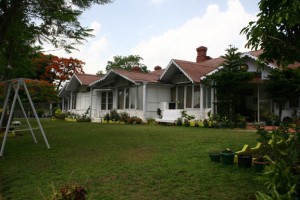The confrontation between Raj Bhavans and the central government during regime change is not a new thing and the first time Governors faced the axe was in 1977 when a party other than Congress assumed power for the first time at the Centre.
As the Janata Party government inaugurated a new trend of dismissing Governors appointed by previous regime led by rivals, the Sarkaria Commission in 1988 said Governors should not be appointed without consulting the states they were being sent to and that they should not be sacked unless there is “some extremely compelling reasons”.
(Mizoram Raj Bhavan)
In 1977, the axing was not easy as the then acting President B D Jatti returned the proposal of Morarjee Desai government without signing it. The Cabinet sent the proposal again and the President had no option but to sign it as per constitutional norms.
As the Janata government showed the way, subsequent governments made it a practice.
In October 1980, then Tamil Nadu Governor Prabhudas Patwari was dismissed by Indira Gandhi government while a year later then Rajasthan Governor Raghulal Tilak too was axed. In both cases, no reason was attributed.
After Congress, who regained power in 1980, was once against ousted in 1989, the V P Singh government then asked all Governors to resign.
In 1998 when BJP came to power, it was reported that then Union Home Secretary B P Singh asked Governors of Gujarat, Goa and Mizoram to put in their papers.
(Raj Bhavan in Nainital, Uttarakhand)
History repeated itself in 2004 when the UPA dismissed Kidar Nath Sahni (Goa), Kailashpati Mishra (Gujarat), Babu Parmanand (Haryana) and Vishnu Kant Shastri (Uttar Pradesh), who were appointed during the tenure of the previous NDA government. This time too, no reason was assigned.
BJP cried foul and then Rajya Sabha MP B P Singhal approached Supreme Court in 2004 against the move. A six-year legal fight ended in 2010 when the apex court ruled that Governors cannot be changed in an arbitrary and capricious manner with the change in government.
Congress had then defended itself saying they were political appointees and they were “for a long time associated with the Sangh Parivar”.
(Goa Raj Bhavan)
However, the UPA did not dismiss NDA appointees like T N Chaturvedi (Karnataka), Madan Lal Khurana (Rajasthan) and M Rama Jois (Jharkhand) then.
The Sarkaria Commission also said repeated shifting of Governors from one state to another can “lower the prestige” of this office to the detriment of both the Union and the state, it said.
The Commission surveyed the tenures of governors from 1947 to 1986 and found that out of the 154 tenures, 104 or two-thirds of them were having a duration of less than five years.
Many governors have held office in more than one state successively without a break. During the period up to October, 1986, 31 persons held 63 tenures of governors. Out of these, 58 tenures were for a period of less than five years. It also found that 35 governors, who served only in one state, did not complete their full tenure.
(An edited version appeared in Deccan Herald on June 18, 2014)



